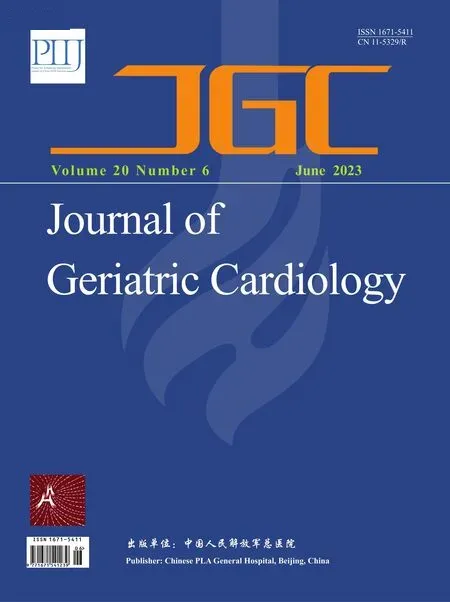Status of cardiovascular disease in China
Zeng-Wu WANG?
Division of Prevention and Community Health, National Center for Cardiovascular Disease, National Clinical Research Center of Cardiovascular Disease, State Key Laboratory of Cardiovascular Disease, Fuwai Hospital, Chinese Academy of Medical Sciences and Peking Union Medical College, Beijing, China
Cardiovascular disease (CVD) has become the leading cause of death and disability in the global population and imposes a significant economic burden on global health systems.Prevalent cases of total CVD nearly doubled from 271 million in 1990 to 523 million in 2019, and the number of CVD deaths steadily increased from 12.1 million in 1990, reaching 18.6 million in 2019.The global trends for disabilityadjusted life years and years of life lost also increased significantly, and years lived with disability doubled from 17.7 million to 34.4 million over that period.[1]Middle-income countries have the highest burden of CVD, with an estimated incidence 30% higher than high-income countries; disability-adjusted life years are almost four times higher in middle-income countries than in high-income countries.[2]
How about the conditions in China? Recently, the “Report on cardiovascular health and diseases in China 2021: an updated summary” gives a description on this issue in theJournal of Geriatric Cardiology.[3]It is estimated that approximately 330 million individuals in China are affected by CVD, including 13 million strokes, 11.39 million coronary heart disease, 8.9 million heart failure, 5 million pulmonary heart disease, 4.87 million atrial fibrillation, 2.5 million rheumatic heart disease, 2 million congenital heart disease, 45.3 million peripheral artery disease, and 245 million hypertension cases.In 2019,CVD accounted for 46.74% and 44.26% of all deaths in rural and urban areas, respectively.Two out of every five deaths are due to CVD.
In addition, China has a large population with risk factors, such as obesity, smoking, physical inactivity, dyslipidemia and etc.A survey among 2.7 million community-dwelling adults aged 35–75 years in the China PEACE Million Persons Project from 2014 to 2018 showed that the age-standardized rate of abdominal obesity was 32.7% in women (waist circumference ≥ 85 cm)and 36.6% in men (waist circumference ≥ 90 cm), which indicated that 1 in 3 adults meeting criteria for abdominal obesity in China.[4]China is the largest consumer and injured state of tobacco products in the world.In 2017,smoking caused 2.6 million deaths in China, which was nearly one-third of annual global deaths from smoking(8.3 million).[5]As to the Chinese dietary pattern, there was a slight increase in the proportion of energy intake from protein and an obvious decline from carbohydrates, the contribution of fat-to-energy intake increased beyond the Chinese Dietary Guidelines recommendation of 20%–30%.[6]In 1980, China had one of the lowest mean non-high-density lipoprotein cholesterol levels, but reached or surpassed non-high-density lipoprotein cholesterol levels of many high-income Western countries in 2018, as high as 4 mmol/L.[7]The prevalence of dyslipidemia in Chinese adults increased significantly from 18.6% in 2002 to 40.4% in 2012.[8]The prevalence of diabetes in Chinese population is increasing significantly,from 0.67% in 1980 to 11.2% in 2017, and the same is true for hypertension prevalence, from 5.1% in 1958 to 27.9%in 2015.[9,10]
In the past 30 years, China’s accessibility and quality index of medical care have made remarkable progress, ranking first among middle-income countries.Many cardiovascular technologies have been at or near the world’s leading level, and China has made significant progress in solving the problem of “treatment difficulty”of CVD.However, due to the prevalence of unhealthy lifestyles among Chinese residents, accelerated population aging and other reasons, the incidence and mortality of CVD in China are still increasing, and the turning point of the decline in disease burden has not appearedyet.The latest assessment data on cardiovascular burden and risk factors can effectively guide the allocation and prioritization of research, healthcare, and public health resources.
For China, the prevention and treatment of CVD still has a long way to go, the priority should be shifted from “disease-centered” to “health-centered” and from“treating the disease” to “preventing the disease”.We should not only do a good job in the secondary prevention and treatment of CVD, but also further strengthen the upstream treatment of hypertension, hyperglycemia,dyslipidemia and other modifiable risk factors in order to curb the trend of increasing incidence and mortality rates of CVD.
 Journal of Geriatric Cardiology2023年6期
Journal of Geriatric Cardiology2023年6期
- Journal of Geriatric Cardiology的其它文章
- Unraveling the mechanisms of a giant coronary sinus
- Iatrogenic pneumopericardium after therapeutic pericardiocentesis for pericardial effusion: a case report
- Target versus sub-target dose of renin–angiotensin system inhibitors on survival in elderly patients with heart failure with reduced ejection fraction: a systematic review and meta-analysis
- Outcomes of catheter-directed thrombolysis versus systemic thrombolysis in the treatment of pulmonary embolism: a metaanalysis
- Nocturnal hypertension and riser pattern are associated with heart failure rehospitalization in patients with heart failure with preserved ejection fraction
- Down-regulation of the Smad signaling by circZBTB46 via the Smad2-PDLIM5 axis to inhibit type I collagen expression
